

Colin Gallaway
Gallaway Safety & Supply has been in business since 2000, and we are proud of our track record of prompt, dependable service. When you choose us for your safety & supply needs, you’ll find that we have the largest in-stock inventory of safety, industrial, and janitorial supplies around along with established partnerships with key manufacturers.
Chemical Filters for Worker Respirators. Modern workplace environments often contain a variety of potentially harmful compounds or biological hazards that are dangerous when inhaled or ingested.
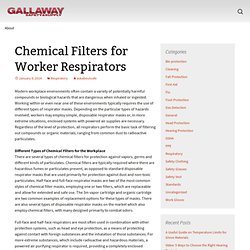
Working within or even near one of these environments typically requires the use of different types of respirator masks. Depending on the particular types of hazards involved, workers may employ simple, disposable respirator masks or, in more extreme situations, enclosed systems with powered air supplies are necessary.
Regardless of the level of protection, all respirators perform the basic task of filtering out compounds or organic materials, ranging from common dust to radioactive particulates. Benefits of Green Cleaning Supplies. It is every employer’s goal to maintain a work site that’s clean and safe for employees and clients.
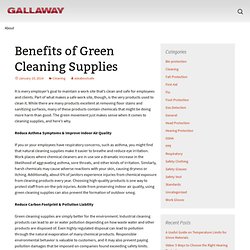
Part of what makes a safe work site, though, is the very products used to clean it. While there are many products excellent at removing floor stains and sanitizing surfaces, many of these products contain chemicals that might be doing more harm than good. The green movement just makes sense when it comes to cleaning supplies, and here’s why. Reduce Asthma Symptoms & Improve Indoor Air Quality If you or your employees have respiratory concerns, such as asthma, you might find that natural cleaning supplies make it easier to breathe and reduce eye irritation. Myths about Hearing Protection. Hearing protection is of the utmost importance to those working around heavy machinery and any potentially damaging decibels of noise.

Noise is a leading cause of hearing loss, yet one-third of all hearing loss can be prevented with proper protection. However, it is essential to choose the correct equipment to ensure maximum protection. Myth: Noise reduction rating is the most important factor. The noise reduction rating, or NRR, is not the most important element of proper hearing protection. The most important factor is comfort and a good fit, which will increase the likelihood of ear protectors being used consistently. Myth: Safety ear plugs and ear push ins cause ear infections. Myth: Hearing protection makes it hard to hear coworkers. Myth: Protective glasses and earmuffs can’t be worn together.
Some people are more susceptible to noise induced hearing loss than others, but once the sensory cells in the ear are damaged, they cannot be restored. Tips for Choosing Better Safety Gloves. Your hands are two of your most important appendages, so it pays to protect them.
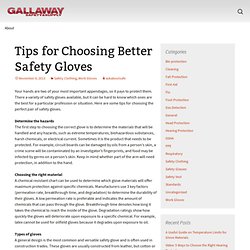
There a variety of safety gloves available, but it can be hard to know which ones are the best for a particular profession or situation. Here are some tips for choosing the perfect pair of safety gloves. Determine the hazards The first step to choosing the correct glove is to determine the materials that will be handled and any hazards, such as extreme temperatures, biohazardous substances, harsh chemicals, or electrical current. Sometimes it is the product that needs to be protected. For example, circuit boards can be damaged by oils from a person’s skin, a crime scene will be contaminated by an investigator’s fingerprints, and food may be infected by germs on a person’s skin.
Choosing the right material A chemical resistant chart can be used to determine which glove materials will offer maximum protection against specific chemicals. Flame Resistant Clothing Products. For industrial workers in utilities, electrical, and oil and gas, exposure to excessive heat and open flames creates a real need for heat protection and flame resistant (FR) clothing.

To suit the needs of safety standards in harsh and dangerous environments, flame retardant work clothes are made of different materials, have different safety grades, and can be layered for multidimensional protection. Upper Body FR Clothing. Disposable vs. Reusable Safety Clothing. Different jobs call for different types of protection.
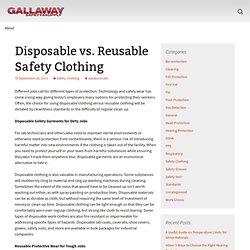
Technology and safety wear has come a long way, giving today’s employers many options for protecting their workers. Often, the choice for using disposable clothing versus reusable clothing will be dictated by cleanliness standards or the difficulty of regular clean-up. Disposable Safety Garments for Dirty Jobs For lab technicians and others who need to maintain sterile environments or otherwise need protection from contaminants, there is a serious risk of introducing harmful matter into new environments if the clothing is taken out of the facility.
When you need to protect yourself or your team from harmful substances while ensuring they won’t track them anywhere else, disposable garments are an economical alternative to fabric. Safety for Temporary Workers. In a recent memo, OSHA announced an initiative to help protect temporary employees from workplace hazards.
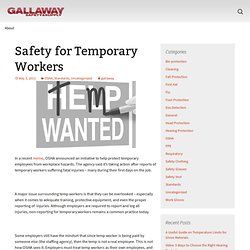
The agency said it’s taking action after reports of temporary workers suffering fatal injuries – many during their first days on the job. A major issue surrounding temp workers is that they can be overlooked – especially when it comes to adequate training, protective equipment, and even the proper reporting of injuries. Although employers are required to report and log all injuries, non-reporting for temporary workers remains a common practice today. Some employers still have the mindset that since temp worker is being paid by someone else (the staffing agency), then the temp is not a real employee.
This is not how OSHA sees it. The new OSHA effort will result in inspectors using a newly created code in their information system to denote when temporary workers are exposed to safety and health violations, and differentiating between temporary workers and permanent workers. Does Your First Aid Kit Meet ANSI Requirements? It is a requirement of OSHA that employees be given a safe and healthy workplace that is reasonably free of occupational hazards.

However, it is unrealistic to expect accidents not to happen. Therefore, employers are required to provide medical and first aid personnel and supplies commensurate with the hazards of the workplace. Although OSHA does not have a specific rule when it comes to the contents of first aid kits, it does reference ANSI Z308.1 Minimum Requirements for Workplace First Aid Kits. In order to meet the ANSI requirement, a basic first aid kit must include the following: (1) First Aid Guide (1) Absorbent Compress 4″ X 8″ minimum (16) 1″ X 3″ Adhesive Bandages (1) Adhesive Tape 2.5 yard roll (10) Antiseptic Treatment Applications 0.9 Gram each (6) Burn Treatment Applications 0.9 Gram each (4) 3″ X 3″ Sterile Gauze Pads (2) Pair Medical Exam Gloves (1) Triangular Bandage 40″ X 40″ X 56″ min (6) Antibiotic Ointment Applications 0.5 Gram each.
Caution!